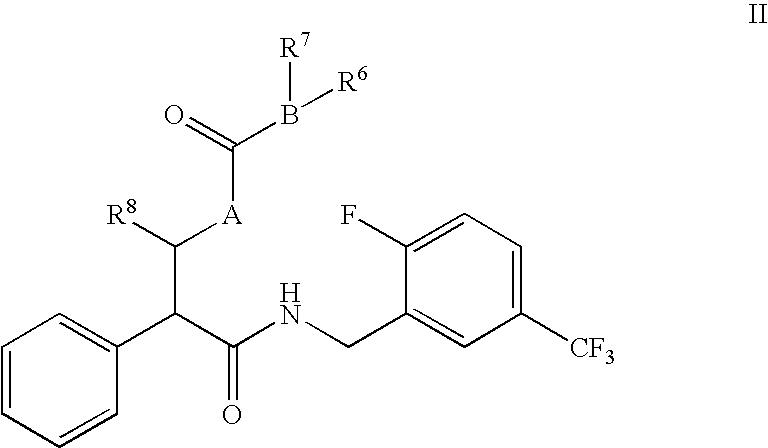N-(2-benzyl)-2-phenylbutanamides as androgen receptor modulators
a technology of androgen receptor and n-(2-benzyl)-2-phenylbutanamide, which is applied in the field of n-(2-benzyl)2-phenylbutanamide derivatives, can solve the problems of hot flushes, significant bone loss, fatigue, etc., and achieves the effects of stimulating muscle growth, reducing skin irritation, and reducing the risk of sarcopenia and frailty
- Summary
- Abstract
- Description
- Claims
- Application Information
AI Technical Summary
Benefits of technology
Problems solved by technology
Method used
Image
Examples
example 1-1
[0466]Examples 1-1 and 1-2 were synthesized in accordance with Scheme 1.
[0467]
(S)—N-(2-fluoro-5-(trifluoromethyl)benzyl)-2-phenylbutanamide (1-1)
[0468]
[0469]A solution of (S)-2-phenylbutanoic acid (1-d, 50 mg, 0.30 mmol, Sigma-Aldrich, Milwaukee, Wis.) and diisopropylethylamine (98 uL, 0.60 mmol) in N,N-dimethylformamide (1 mL) was treated at room temperature with benzotriazol-1-yloxytripyrrolidinophosphonium hexafluorophosphate (PyBop, 158 mg, 0.30 mmol). After 15 min, (2-fluoro-5-(trifluoromethyl)phenyl)methanamine (1-g, 60 mg, 0.30 mmol, Synthesis, Inc., Wyndham, N.H.) was added. The reaction mixture was stirred for 3 h, partitioned between dichloromethane and 0.5N—NaOH. The aqueous layer was removed and the organic layer was washed with 0.5N—HCl. The aqueous layer was removed by filtering through a plastic frit. The organic layer was concentrated in vacuo to give the desired product (1-1); HRMS (M+1)=340.129: 1H NMR (500 MHz, CDCl3) δ7.49 (bs, 1H), 7.41 (d, 1 H, J=6.5 Hz), 7.34–...
example 1-2
N-(2-fluoro-5-methylbenzyl)-2-phenylbutanamide (1-2)
[0470]
[0471]A solution of (2-fluoro-5-methylphenyl)methanamine (1-f, 50 mg, 0.26 mmol, Oakwood Products, Inc., West Columbia, S.C.) and diisopropylethylamine (88 uL, 0.52 mmol) in dichloromethane (1 mL) was treated at room temperature with 2-phenylbutanoyl chloride (1-a, 47 mg, 0.26 mmol). The reaction mixture was stirred for 30 min, partitioned between dichloromethane and 0.1N—NaOH. The aqueous layer was removed and the organic layer was washed with 0.1N—HCl. The aqueous layer was removed by filtering through a plastic frit. The organic layer was evaporated in vacuo to give the desired product (1-2); HRMS (M+1)=286.1586.
[0472]Additionally, Examples 1-3 through 1-28 in Table 1 below were prepared by the general protocols described in Scheme 1. Specific details of the synthesis of particular compounds are presented below.
[0473]Examples 1-6 through 1-9 were obtained by direct introduction of ethyl, vinyl or cyclopropyl group to the c...
example 1-3
[0485]Compound 1-3 was synthesized as shown in Scheme 3 and described below.
[0486][0487]Step A (S)—N-((2-amino-5-(trifluoromethyl)pyridin-3-yl)methyl)-2-phenylbutanamide (3-g)
[0488]
[0489]A solution of 5-(trifluoromethyl)pyridin-2-amine (3-a with R4=CF3, 1.6 g, 9.87 mmol) (Maybridge Chemical company, Cornwall, England) in N,N-dimethylformamide (30 mL) was treated at room temperature with silver sulfate (3.1 g, 9.87 mmol) and iodine (2.5 g, 9.87 mol). The reaction mixture was stirred for 14 h and filtered. The filtrated solution was concentrated in vacuo. The residue was chromatographed (SiO2, 25% ethyl acetate in hexanes) to give 5-(trifluoromethyl)-3-iodopyridin-2-amine (3-b, with R4=CF3). The iodide (3-b, with R4=CF3, 1.0 g, 3.47 mmol) and cuprous cyanide (CuCN, 78 g, 8.68 mmol) was dissolved in N,N-dimethylformamide (6 mL) and heated under the microwave at 100 C for 30 min, cooled to ambient temperature, and diluted with ethyl acetate. The precipitates were removed by filtration. ...
PUM
| Property | Measurement | Unit |
|---|---|---|
| pH | aaaaa | aaaaa |
| thickness | aaaaa | aaaaa |
| density | aaaaa | aaaaa |
Abstract
Description
Claims
Application Information
 Login to View More
Login to View More - R&D
- Intellectual Property
- Life Sciences
- Materials
- Tech Scout
- Unparalleled Data Quality
- Higher Quality Content
- 60% Fewer Hallucinations
Browse by: Latest US Patents, China's latest patents, Technical Efficacy Thesaurus, Application Domain, Technology Topic, Popular Technical Reports.
© 2025 PatSnap. All rights reserved.Legal|Privacy policy|Modern Slavery Act Transparency Statement|Sitemap|About US| Contact US: help@patsnap.com



